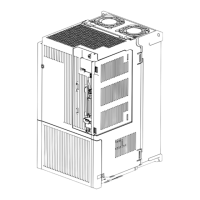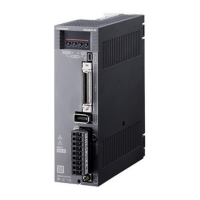12. ABSOLUTE POSITION DETECTION SYSTEM
12 - 14
12.4 Signal explanation
When the absolute position data is transferred, the signals of connector CN1 change as described in this
section. They return to the previous status on completion of data transfer. The other signals are as described
in section 3.5.
For the I/O interfaces (symbols in the I/O Category column in the table), refer to section 3.8.2.
Signal name Code
CN1
connector
pin No.
Function/Application
I/O
category
Control
mode
ABS transfer mode ABSM
(Note)
17
While ABSM is on, the servo amplifier is in the
ABS transfer mode, and the functions of CN1-22,
CN1-23, and CN1-25 are as indicated in this
table.
DI-1
ABS request ABSR
(Note)
18
Turn on ABSR to request the absolute position
data in the ABS transfer mode.
DI-1
ABS transmission data
bit 0
ABSB0 22
Indicates the lower bit of the absolute position
data (2 bits) which is sent from the servo to the
programmable controller in the ABS transfer
mode. If there is a signal, D01 turns on.
DO-1
ABS transmission data
bit 1
ABSB1 23
Indicates the upper bit of the absolute position
data (2 bits) which is sent from the servo to the
programmable controller in the ABS transfer
mode.
DO-1
P
(Position
control)
ABS transmission data
ready
ABST 25
Indicates that the data to be sent is being
prepared in the ABS transfer mode. At the
completion of the ready state, ABST turns on.
DO-1
Home position setting CR 41
When CR is turned on, the position control
counter is cleared and the home position data is
stored into the non-volatile memory (backup
memory).
DI-1
Note. When "Used in absolute position detection system" is selected in [Pr. PA03], pin 17 acts as ABSM and pin 18 as
ABSR. They do not return to the original signals if data transfer ends.

